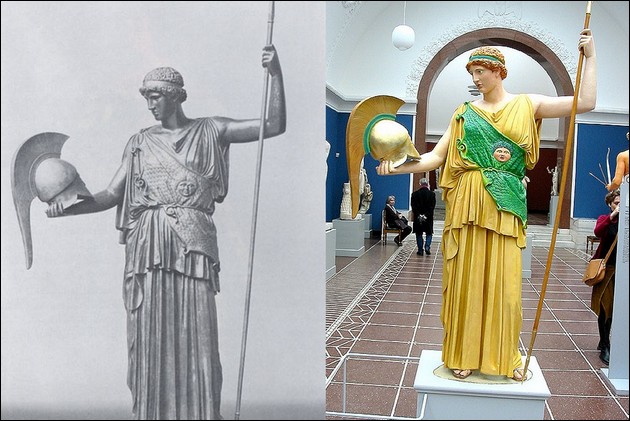|
System Metternich posted:That's super interesting, can you recommend some literature about it?
|
|
|
|

|
| # ? May 14, 2024 09:08 |
|
Vaginal Vagrant posted:Quidam Viator marry me. System Metternich posted:That's super interesting, can you recommend some literature about it? Aubergine Mage posted:That was wonderful Ummmm....I don't know what to say. I'm not used to people liking my stuff, so some part of me feels like I'm being trolled. I have some kind of SA-related trauma, apparently. So, thanks? I could try to pull up my graduate thesis from 16 years ago, before I started teaching, but more than anything, I found that there was no real literature that specifically did what I was trying to do. And I don't blame academics for that; you can see how much I have to keep hedging. Really picky readers could attack anything I put forward as a really concrete hypothesis as to when cultures really internalized, metaphorized and verbalized their lateralization preferences. "OH YEAH??? Well, the early Romans thought the worst possible disgrace for an army was being made to pass UNDER a YOKE, because the yoke was used on cattle and slave animals, and it showed that someone was above you, so therefore, Early Republican Romans MUST have thought up was better than down!" At this point, I would like to point that the English "yoke", the Latin "iugulum", and perhaps shockingly, the word "yoga", all derive from the same Proto-Indo-European stem, *yeug- "to join". And for all the posturing in India about a 5,000 year culture, the practice of yoga, of "yoking oneself" to the divine, isn't written down until... well about 500 BCE, so it's another Axial Age concept! See, this whole idea is not just about archaeology, or philosophy of mind, or history of ideas, but really about biology and etymology, and how human language and consciousness were born out of trying to create language using only primal absolutes. So, in a way, trying to push such a high-level examination of the whole concept of lateralization preference is kind of my own thing. This is NOT to say that there aren't a million people working at different chunks of the problem. Hell, everyone "knows" about the two hemispheres of the brain. We have great science being done on what's called the "laterality-valence hypothesis", where mammal experiments show that the right hemisphere may be more responsible for retreating, negative, withdrawal reactions, and the left hemisphere more responsible for governing "positive", approaching interactions. http://link.springer.com/article/10.1007/s10071-015-0928-3 And yes, this encoding of "left hand - GROSS, BACK OFF" and "right hand - OK, MOVE FORWARD" can be connected to the origin of civilization. There's a current thesis in anthropology and moral psychology that the main emotion motivating the origin of civilization was not LOVE, but DISGUST. Here, you can read all about that, and try to keep in mind that there's a clinically-demonstrated, biologically-rooted lateralization of left/right, forward/back reactions that MIGHT inform which emotions we express to create culture. https://aeon.co/essays/how-disgust-made-humans-cooperate-to-build-civilisations This opens a gigantic hypothetical can of worms. If I WERE to recommend a book, it would be an outdated, speculative, and controversial one, that still has had a lot of impact: The Origin of Consciousness in the Breakdown of the Bicameral Mind by Julian Jaynes. Reading his work first put me on this path. His hypothesis is radical: the evolution of the human interface with lateralization can be seen as a developing process from the earliest cultural artifacts and writing, and his contention is that we can observe, just in these past five-thousand years, the actual origin of modern consciousness from a previous, more biologically-fundamental version. Yeah, it's nuts. It provides a functional explanation why people thousands of years ago ACTUALLY DID interact with gods, angels, and divinities, and bases it all not on mysticism, but biology and culture. Jaynes points out that all of our standard speech areas, Wernicke's area, Broca's area, and the supplemental motor area, are all left-lateralized (and therefore associated with right-side dominance in handedness and eye preference). Why would such a critical function be put on only one side of the brain instead of both? He hypothesizes that there is a set of vestigial RIGHT-hemispheric speech centers, which generated internal voices of commands, and claimed that when schizophrenics heard commanding voices, that this ancient speech center lit up and sent information across the anterior commissures, literally bringing the commands of the gods over into what would BECOME the modern identity or consciousness. In other words, what made the ancient god-king societies function was a very prevalent mass schizophrenia, where the imposing ziggurats and monuments induced a kind of hive-minded, mass hallucination that allowed humanity to transition from living in small groups to large, and eventually to abandoning or losing the voices of the gods as they evolved what we call modern consciousness, all VEEERRRYY recently. Yeah, I know. I have to post a giant study from Oxford about how schizophrenia is a lateralization dysfunction to take the curse off that craziness! http://brain.oxfordjournals.org/content/128/5/963 Seriously, you put a schizophrenic into an fMRI while they are hearing voices of command, and the mirrored, forgotten parallels to our modern speech centers light up like a god drat Christmas tree. https://www.ncbi.nlm.nih.gov/pmc/articles/PMC4273663/ So, I'm not crazy, and I don't think Jaynes was either. The basic proposal is that the earliest civilizations we know were not fully conscious like we were; instead, they had a predilection for much more balanced brain activity: the left-hemispheric mind did all the rote, standard, daily-living work of tool use, work, language, and routine analysis. Meanwhile, if something REALLY crazy or stressful happened, which was pretty much all the time, the RIGHT brain would kick in, speak in a divine, commanding voice, perhaps even create a visual hallucination of a relative, friend, or god touching or commanding you, and would give you the solution to implement to relieve the stress. poo poo, Jaynes does an in-depth reading of the Iliad, and shows that the "humans" of that time didn't think in a modern way AT ALL. They didn't have a centralized sense of identity or body holism, instead thinking of people as a collection of parts, but more than anything, he claims that nobody in the Iliad makes a personal choice or is able to LIE in stressful decisions. Seriously, every time Achilles or Agamemnon get stressed about what to do about Briseis, a motherfucking deity reaches in and tells them what to do. And the other motherfuckers ACCEPT THIS AS A VALID EXPLANATION. Why all this rambling? When you ask questions about which side we prefer, whether we like up or down, or forward or back, you're asking a question that goes all the way down into really fine biology, and is expressed in every level all the way up to the most abstract language and concepts. I taught history, classics, and Latin for 15 years. My general proposal to my students was that the minds of people from other times and places are more radically different than ours than they are the same, and that if we develop a nose for sniffing out those differences, we begin to get to a REAL understanding, not just of them, but of ourselves. The more distant the perspective and deep the understanding of difference, the greater the leverage you have to move your world. History! EDIT: Well, this link has been up for years, so I GUESS it's of some valid copyright state, but if not, I'm sure a mod will remove it. Here's the Jaynes book. Enjoy: http://selfdefinition.org/psychology/Julian-Jaynes-Origin-of-Consciousness-Breakdown-of-Bicameral-Mind.pdf Quidam Viator has a new favorite as of 15:32 on Oct 31, 2016 |
|
|
|
 Okay, that's actually super fascinating. How's all that intersect with modern-day societies where things like witchcraft, possession and such are still accepted as valid? For instance, Turner's work among the Ndembu springs to mind.
|
|
|
|
alriclofgar on Reddit posted:On a purely practical level, bronze makes better weapons than (pure) iron. Bronze has a Vicker's hardness (HV) of about 300, while pure iron is closer to 100HV. Practically speaking, that means that iron weapons are more difficult to keep sharp and are more likely to bend. You may have heard of the passage from Caesar's Gallic Wars where the barbarian warriors have to stop mid-battle and straighten their bent iron swords? Metallographic analyses of surviving swords from the period suggest that this was probably a true story. Gallic swords were typically made from pure iron with very high ductility (easily bent), and would not have stood up well to a protracted fight. Early iron weapons were, on the whole, not very good, and this didn't really change until steel became widespread in the early middle ages. Given a choice between a well-made bronze spear and an iron spear from antiquity, I would probably choose to fight with the bronze. Cite is: Gosden, C., (2012), Material, Magic and Matter: understanding different ontologies: in “Maran, J. and Stockhammer, P. (eds) Materiality and Social Practice. Transformative Capacities of Intercultural Encounters”, pp 13-19, Oxford: Oxbow Books.
|
|
|
|
Platystemon posted:Cite is: Gosden, C., (2012), Material, Magic and Matter: understanding different ontologies: in “Maran, J. and Stockhammer, P. (eds) Materiality and Social Practice. Transformative Capacities of Intercultural Encounters”, pp 13-19, Oxford: Oxbow Books. This reasoning seems kind of backwards to me. The collapse of long trade routes resulted in people being more reliant on local resources, and therefor they developed iron-working? It seems to me like the opposite would be true. Once people figured out how to make weapons out of iron they no longer had to pay tribute to distant monopolies, and rag tag bands of raiders could make iron weapons (where it took a large organized government to make bronze weapons). Which is why all of the bronze age civilizations collapsed, because the social/war/power structure built up around bronze was no longer viable. Rutibex has a new favorite as of 16:35 on Oct 31, 2016 |
|
|
|
There’s a gap of centuries. Order of events is clear, if not causation.
|
|
|
|
As a little kid in Nebraska, I recall adults would point out a certain kind of plane in the sky and call it a "looking glass". Turns out that was indeed a thing, planes would alternate carrying top generals up so there was always a commander airborne in case WWIII broke out so they could carry on a "mirror image" of operations if we lost our ground folks. This small detail is pretty  : :quote:At DEFCON 2 or higher, the Looking Glass pilot and co-pilot were both required to wear an eye patch, retrieved from their Emergency War Order (EWO) kit. In the event of a surprise blinding flash from a nuclear detonation, the eye patch would prevent blindness in the covered eye, thus enabling them to see in at least one eye and continue flying. Later, the eye patch was replaced by goggles that would instantaneously turn opaque when exposed to a nuclear flash, then rapidly clear for normal vision. TapTheForwardAssist has a new favorite as of 16:55 on Oct 31, 2016 |
|
|
|
Those are some steely‐eyed aviators. https://www.youtube.com/watch?v=OgCLMI3fgn0
|
|
|
|
Siivola posted:
Again, I'd point you to the Jaynes book, because he's already done so much of the anthropological heavy lifting to provide even a framework for these wild claims. However, put simply, the idea of "bicamerality", that shared agency between the "identity" of the left-brain, speech-producing, "rational" mind, and the "intuition" of the right-brain, abstract, "imaginative" brain is not an eliminative concept. People like to reduce evolutions into hard transitions from one thing to another. If you read that McAuliffe article on Aeon, you'll see that there's an immense amount of evolutionary crossover between what we adapted to do just as animals, what we adapted to 50,000 years ago as pre-conscious humans, and what we adapted to during the rise of agriculture 10 kya, the rise of language 5kya, and a bunch of stages since then. The rate at which a culture or even a subgroup of a culture transitions through those periods is incredibly variable, and dependent upon every force that is a part of human existence. In Western civilization, we have many turning points. Have you read 1177 B.C.: The Year Civilization Collapsed (Turning Points in Ancient History)? It talks about a major inflection point around which the cultures of the Mediterranean turned. Jaynes will go so far as to say that the meeting of the Conquistadors and the Aztecs or Inca was LITERALLY a meeting of two different versions of human consciousness. The Americans were still operating under a god-king theocracy, and were bicameral, incapable of easy lying and deception, bound to rigid structures, and crippled by stressors beyond what their highly-regimented civilization could absorb. Meanwhile, the Europeans had a modern, left-brain dominant consciousness, with an analog I, a sense of self, and the ability to construct elaborate strategies. So, your question about Turner and the Ndembu is very prescient: There is a great amount of high-level, CULTURAL liminality here. If we thought of a culture as a person, we could see the European culture of the 16th century as having gone through a series of rites of passage that had not yet become available to the Americans of that time. But, as you well know, liminality is not exclusive or eliminative, which brings me full circle. You were probably thinking metaphorically about Turner's idea of "multivocality" now not only applied to ritual objects, but to humans as part of a society as multivocal ritual objects themselves. A modern day Jew talking about Yahweh is partially expressing voices from the entire range from almost 4 kya to the modern day. Evolution does not just throw away its foundations. It should be clear that to whatever extent a human being living in modern, Western, "rationally conscious" culture believes in mystical things such as, but not limited to witchcraft, possession, angels, devils, demons, ghosts, gods, and magic, is the extent to which that individual has drunk from the same well as the Ndembu. And it should be abundantly clear that this is no condemnation of those who believe, but rather an attempt to grasp at a theory that can both explain the evolution of consciousness, and account for the stunning variances in cultural and civilizational beliefs that have been open to use on the world stage since writing. I tend to follow this idea of a progression from Edenic, animal humanity to a crisis which demanded bicameral, bilateralized thinking, to another crisis which created a series of breakdowns in the bicameral mind, which leads us to our modern, heterogeneous mental condition. All of this study was precipitated by the realization in my freshman year of college that I had no capacity for internal visualization or audialization, and so was shut out from what most people call imagination. The modern consciousness asserts itself as fully aware and conscious and yet people can still dream, picture things in their head, have elaborate fantasies, have internal conversations, and still claim to be able to make a clear distinction between rational, conscious, reality and the mystic world of fantasy. This leaves me with all sorts of questions about liminality and reality, but this is veering far away from the historical, so I'll stop again.
|
|
|
|
I've only been studying anthropology for bit over a year so a lot of that goes over my head, but thanks!
|
|
|
|
Hasn't that left-right brain stuff been called a brilliant idea without a shred of evidence to back it up?
|
|
|
|
Quidam Viator posted:Ummmm....I don't know what to say. I'm not used to people liking my stuff, so some part of me feels like I'm being trolled. I have some kind of SA-related trauma, apparently. So, thanks? bicameralism is utter bullshit
|
|
|
|
Hogge Wild posted:bicameralism is utter bullshit HEYYYYY that's the SA experience I'm used to! Thanks for makin me feel at home, pardner.
|
|
|
|
Quidam Viator posted:HEYYYYY that's the SA experience I'm used to! Thanks for makin me feel at home, pardner. I genuinely enjoyed your posts and would like more of them. Unproven scientific theories can still be great tools for fiction. The idea of a bicameral culture meeting and trying to communicate with a unicameral one sounds like it could be some great sci-fi. What do you mean when you say you can't imagine things?
|
|
|
|
Request (or, more specifically, a request to see if this actually happened or if the story I read was apocryphal: I recall reading a story about some feudalism-era (I think?) painter who, as was the style at the time, drew women in their "ideal" state: plump and hairless. Did a ton of them. When he got married, however, he freaked out on his wedding night because he was suddenly faced with an actual woman who wasn't plump and had hair down there. As this half-remembered story goes, he immediately flees the scene, gets a divorce, and becomes a monk/priest/whatever for the rest of his life. I've tried googling this off and on for a long time to no avail, so I'm inclined to think it's bullshit, but it almost kinda makes sense.
|
|
|
|
MisterBibs posted:Request (or, more specifically, a request to see if this actually happened or if the story I read was apocryphal: I have heard this story too! I think it's the guy who painted a bunch of english ladies with bulbous eggy heads. I think it's at least documented that Louis XVI, Marie Antoinette's husband, had never seen female genitalia before marrying her and found it horrifying.
|
|
|
|
Serious question: I read about theory/hypothesis that's as follows: ancient humans tried to understand animals on more than an instinctive level - they tried to understand what the animals were thinking. This was an useful skill during hunting so evolution kept it. But this "imagination of another mind" had a side effect. Humans tried to apply it to anything that seemed to be 'alive' in any way. Nature. The sun and stars. The weather. Humans tried to predict them by imagining what those parts of the world were thinking. And sometimes, it even seemed to work. This is how the concept of gods/spirits/whatever was born, and why ancient religions had a god for every single power of nature. And because the skill to imagine other minds is so incredibly useful, we kept it, and if anything we got better at it. And with it grew our ability to imagine minds where there weren't any. Gods. It's been part of us since the Stone Age, at the least. This explains why so many people believe in the supernatural even now. How does this theory tie in with the one you are talking about, if at all?
|
|
|
|
Hogge Wild posted:bicameralism is utter bullshit
|
|
|
|
Quidam Viator posted:Evolution does not just throw away its foundations. It should be clear that to whatever extent a human being living in modern, Western, "rationally conscious" culture believes in mystical things such as, but not limited to witchcraft, possession, angels, devils, demons, ghosts, gods, and magic, is the extent to which that individual has drunk from the same well as the Ndembu. Here's where i'm not following you though. People in the distant past believed in these things and saw them acting in the world because they weren't "conscious" as Jaynes puts it, weren't capable of introspection, perceived themselves being acted on by the right-brain voice. But people who are living right now, whom you can meet and talk to, who are conscious and capable of introspection seem to believe in these things and see them acting in the world in pretty much the same way? It starts to sound a like a lot of old timey race science being propped up around a little bit of modern neuroscience, especially in that second part of the quote and the part about the colonization of the americas
|
|
|
Tiny Brontosaurus posted:I have heard this story too! I think it's the guy who painted a bunch of english ladies with bulbous eggy heads. I think it's at least documented that Louis XVI, Marie Antoinette's husband, had never seen female genitalia before marrying her and found it horrifying. They don't put pubes on sculptures.
|
|
|
|
|
Decrepus posted:They don't put pubes on sculptures. They might have painted them on though. A lot of classical statues were really colorful originally, and probably much more detailed than our reconstructions can show  I believe the analysis we use to recreate painted statues can only show the bottom layer of color, so we shouldn't assume they painted everything flat. There are definitely classical examples of painting that's just as masterful as the renaissance 
|
|
|
|
Werewolf!
|
|
|
|
Samovar posted:Werewolf! There. There wolf. There castle!
|
|
|
|
Samovar posted:Werewolf! I dunno, you had him last.
|
|
|
|
Tiny Brontosaurus posted:They might have painted them on though. A lot of classical statues were really colorful originally, and probably much more detailed than our reconstructions can show I always wondered why they would go to all the trouble of carving an intricate marble statue, only to paint it like the mass produced Ronald McDonalds you see outside of restaurants. If you are going to paint them so gaudy you may as well make them out of molded concrete. Did Romans every make concrete statues? Rutibex has a new favorite as of 23:12 on Oct 31, 2016 |
|
|
|
Rutibex posted:I always wondered why they would go to all the trouble of carving an intricate marble statue, only to paint it like the mass produced Ronald McDonalds you see outside of restaurants. It’s simple: they didn’t have mass‐produced Ronald McDonalds.
|
|
|
|
Rutibex posted:I always wondered why they would go to all the trouble of carving an intricate marble statue, only to paint it like the mass produced Ronald McDonalds you see outside of restaurants. If you are going to paint them so gaudy you may as well make them out of molded concrete. Did Romans every make concrete statues? That's what I'm saying, they didn't paint them gaudy. Our reconstructions look gaudy because we have no way of determining how they did highlights and shadow.
|
|
|
|
MisterBibs posted:Request (or, more specifically, a request to see if this actually happened or if the story I read was apocryphal: Tiny Brontosaurus posted:I have heard this story too! I think it's the guy who painted a bunch of english ladies with bulbous eggy heads. I think it's at least documented that Louis XVI, Marie Antoinette's husband, had never seen female genitalia before marrying her and found it horrifying. Pretty sure you're thinking of John Ruskin, the enormously influential 19th-century British art critic. His marriage was annulled because of non-consummation, and the rumour went round that he'd spent so much time looking at Classical depictions of the female form he wasn't prepared for the existence of pubic hair. He definitely had some odd complex where his wife (and possibly women in general) were concerned, but there's no direct evidence for the pubes thing, and the fact that she was having a fairly public affair with the painter John Millais probably didn't help.
|
|
|
|
Maybe they didn't seem gaudy to the romans, since they didn't have poo poo like mcdonalds to associated those colour schemes with.
|
|
|
|
Slime posted:Maybe they didn't seem gaudy to the romans, since they didn't have poo poo like mcdonalds to associated those colour schemes with. People for a long time would've killed for the sort of trivially cheap bright pigments that mcdonalds' garishness is made of.
|
|
|
|
Rutibex posted:I always wondered why they would go to all the trouble of carving an intricate marble statue, only to paint it like the mass produced Ronald McDonalds you see outside of restaurants. If you are going to paint them so gaudy you may as well make them out of molded concrete. Did Romans every make concrete statues? I saw some researcher say in a documentary about the statue colors too that some of these statues were not exactly viewable up close, because they might be on top of a 30 ft tall building and only really visible in daylight. In that case, higher contrast makes the underlying sculpted details easier to see. Sorta like how stage makeup and costumes look garish and bad up close but look correct when viewed from long distances under bright lights. That same documentary was describing how the Chinese tomb terracotta soldiers were all painted with crazy expensive lacquer. In present day, it peels up and falls off within a few minutes of being exposed to open air after excavation.
|
|
|
|
Tiny Brontosaurus posted:They might have painted them on though. A lot of classical statues were really colorful originally, and probably much more detailed than our reconstructions can show
|
|
|
|
Carbon dioxide posted:Serious question: I read about theory/hypothesis that's as follows: ancient humans tried to understand animals on more than an instinctive level - they tried to understand what the animals were thinking. 
|
|
|
|
On the WWI topic, and paraphrasing since it's from a documentary I saw. As an artillery guy, I loved the bit in the doco where they quoted some British general from early in WWI complaining "is there some sort of Freemasonry between the British and German artillery, some friendly conspiracy? They'll shell the hell out of the opposite side's infantry all day long, and never a shot at each other!" This makes sense for a couple reasons, first being that fire direction was relatively new, artillery was only a generation or two away from "visibly look down the top of your barrel at what you're shooting at" to being able to shoot at targets well outside of visual range through use of observers or detailed maps. WWI was where they started to do echolocation to triangulate enemy artillery (a primitive version of what we'd now call anti-battery radar), and having much better forward observation with frontline observers telegraphing or semaphoring back changes, from the ground or from planes or balloons. But especially at the early stage it'd take a lot of luck and blind firing, which brings us to the other key point: Shelling enemy grunts in the distance is great because they can't immediately threaten you. If by dint of balloon observers or scouts telegraphing back map grid coordinates you start trying to feel out the enemy artillery, you just gave them a huge reason to fire back at *your* artillery, and it turns into one very non-fun game of You Sunk My Battleship with guys throwing hundreds of pounds of steel and high explosive at people they can't see. So instead it was just way easier and safer to hammer on the grunts, with kind of an unspoken understanding that nobody wanted to start battery-on-battery poo poo, though as I understand that started going away as it got easier and easier to properly zero in on enemy positions. I recall clearly in the 2003 Iraq invasion, counter-battery fire was one of the biggest worries the artillery guys had since the Iraqis had these fine Austrian howitzers that slightly outranged ours. Not that it ended up mattering much since we either pulverized those from the air or called their Iraqi commander's cell-phone and talked him into sending everyone home on leave that week and just lay low until this all blows over. In retrospect, "battery defense", protecting the battery from ground attacks, given all the irregular units that started running around, should've been a much bigger worry.
|
|
|
|
achillesforever6 posted:Wonder how expensive it used to be to paint in ancient times to get some really vivid colors; I know purple and blue were probably the most expensive colors to make. I learned reading Bill Bryson's excellent At Home: A Short History of Private Life that good black paint wasn't available until the late industrial age. All those period pictures with Victorians walking around in front of black-painted iron railings? All wrong! Might as well have cavemen riding dinosaurs in the background.
|
|
|
|
Tiny Brontosaurus posted:I learned reading Bill Bryson's excellent At Home: A Short History of Private Life that good black paint wasn't available until the late industrial age. All those period pictures with Victorians walking around in front of black-painted iron railings? All wrong! Might as well have cavemen riding dinosaurs in the background.
|
|
|
|
Cumslut1895 posted:Wouldn't they be naturally black wrought iron? I think unpainted wrought iron is more of a graphite gray.
|
|
|
|
Gato posted:Pretty sure you're thinking of John Ruskin, the enormously influential 19th-century British art critic. His marriage was annulled because of non-consummation, and the rumour went round that he'd spent so much time looking at Classical depictions of the female form he wasn't prepared for the existence of pubic hair. He definitely had some odd complex where his wife (and possibly women in general) were concerned, but there's no direct evidence for the pubes thing, and the fact that she was having a fairly public affair with the painter John Millais probably didn't help. I've heard this story about Ruskin too. I was also taught that Classical female statues didn't have pubes specifically because Praxiteles sculpted a Venus without them and everyone loved it so much that other sculptors imitated him, but I can't remember if that's true or not. This Venus was apparently so attractive that one young man tried to have sex with it. Decrepus posted:They don't put pubes on sculptures. Yes people do. Check out David, and that's in marble, much harder to sculpt than most Classical statues. HEY GAL posted:odysseus lied all the time IIRC Jaynes thinks things changed for Homer between the Iliad and the Odyssey but that seems obviously drivel even if the theory as a whole is a cool science fiction idea.
|
|
|
|
Tiny Brontosaurus posted:I learned reading Bill Bryson's excellent At Home: A Short History of Private Life that good black paint wasn't available until the late industrial age. All those period pictures with Victorians walking around in front of black-painted iron railings? All wrong! Might as well have cavemen riding dinosaurs in the background. Than what the heck was Caravaggio painting with in the 17th century? 
|
|
|
|

|
| # ? May 14, 2024 09:08 |
|
Rutibex posted:Than what the heck was Caravaggio painting with in the 17th century? Custom pigments he almost certainly mixed himself, which has nothing to do with the commercial paint I was talking about
|
|
|






























